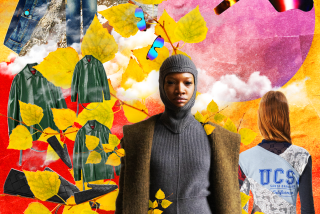Stuck on ‘80s Rewind
MILAN, Italy — In the age of instant information and easy money, the life of a fashion trend gets ever shorter. Shoppers tire faster of trendy clothes, and designers oblige with replacements every season. In the swirl, everyone grasps for the easy ideas--1980s! Cleavage! Belts! Real innovation, meanwhile, gets stuck on rewind.
The game is growing tedious as designers here unveil their spring 2001 collections. Even Gucci designer Tom Ford has had enough. “I’m so sick of retro, of vintage, of the ‘90s,” said Ford at a pre-show news conference as editors nodded, “Amen!”
“There’s a silhouette that has taken over the world. It’s a long, lean silhouette--with tight pants and high heels,” Ford continued. “When fashion hits a point when everyone is dressing the same way, you lose that edge that makes fashion exciting and a little shocking.”
Ford reacted with a new-to-Gucci silhouette: peg-leg pants with a full, pleated front, and sharp-shouldered, nipped-waist jackets. He promised clothes that would accentuate structure and the female form, adding, “The most important accessory you will need this season is a bra.”
Out they came--stiff little cups under sleek black dresses, translucent sweaters and fetish-like corsets minus the cups that made the breasts sit like cupcakes on a ledge. The models, with their slick hair and smoky eyes, could have been dancing behind Robert Palmer as he sang “Addicted to Love.”
Ford may be sick of retro, but his pleat-front pants are a hallmark of the ‘80s (remember baggies?), along with padded-shoulder suits and cone-heel pumps. His cobalt or black satin cargo pants with pockets bigger than a September Vogue were pretty enough. But the idea is a little stale, years after John Galliano did a version for Christian Dior--and kids do them daily. His purple or black satin boxlike bags playfully recalled old-fashioned canteens as they bounced against his military-style jackets.
Some designers have taken themselves out of the fray and found new strength in the seemingly revolutionary idea of a classic silhouette done with simple, good taste.
On his 25th anniversary of his company, Giorgio Armani gave fashion a double treat, a new concept in superstores and a collection that nudged his trademark look gracefully forward. On the morning of his main show, the master himself led a tour of the three-level store, Armani/Via Manzoni 31, as workers installed lighting and unwrapped sofas. Under one big, Armani-ized roof, the designer installed departments for flowers, books, art, the latest Sony gadgets, a Nobu sushi restaurant, a new home furnishings collection, and the jeans and Emporio collections. Armani may open a Casa Armani housewares store in Los Angeles within the year, but not a superstore, just yet.
“This is a very expensive operation,” he said. “Before I start doing it all over the world, let’s see how it goes.”
Hours later, he presented a fresh-feeling Armani signature collection that he described as having “nothing in common with the current ostentation.” Except for the suspender pants, none of the clothes will look dated a year, or two or three, from now. He included current trends for shirring, asymmetry, extra-wide and deep necklines, and shaped jackets with sharper, wider shoulders, while offering several pant and jacket shapes and above-the-knee beaded evening dresses.
Earlier in the week, his similarly strong Emporio collection blended fun and simplicity. One giant quilted flower became a strap-on halter top, while fabric corsages anchored waistlines and necklines. Other key looks: shirred camisole tops, wrap-around loose pants and multiple suede ribbons used as dress straps or skirt belts.
Somewhere between Armani’s classics and Gucci’s ‘80s soldiers came Prada. The dual-themed collection lacked Miuccia Prada’s usual wit, originality and must-have accessories but reflected the season’s split personality.
Backstage, Prada explained that she blended the ‘80s with the ‘50s, and also presented two separate identities. “One is very serious, very tough,” she said. “The other is just the opposite--feminine and colorful.” One wore dull cotton, military-inspired navy shirts, jackets and knee-length pleated skirts. The other, silky pink raglan-sleeve blouses or floaty, two-layer dance skirts.
Her takes from the Reagan years: tiny swing jackets, flimsy tube skirts and pumps with acid-toned cone heels. From the Eisenhower era: full, pleated knee-length skirts in silk jersey, A-line tap pants and black anklets with sling-backs. Her new emphasis on the waist materialized in knit bands worn like cummerbunds over crisp blouses or with sweaters cropped just under the bust line. It hasn’t been well received. Said one retailer: “It looked like what a girl wears to visit her cat or her invalid mother.” “Prison guard,” said another.
It’s no wonder designers look to the past when the present is so confusing. The industry’s new era has its graying designers selling off or seeking new blood. Jil Sander quit her namesake line after conflicts with Prada, its new owners. This season, an anonymous team designed the clothes. They faithfully recalled the spirit of Jil Sander with androgynous pantsuits, austere shirts and a few relaxed cowl-neck sweaters.
The 45-year-old Krizia house added a new line, Krizia Top, headed by designer Alber Elbaz, who was ousted from Yves Saint Laurent when the ready-to-wear line was acquired by Gucci. As if to prove his ability to work in the Yves Saint Laurent style, Elbaz marched Saint Laurent-inspired silhouettes across a theater’s stage. It was a fine performance, with the right balance of real-world practicality and graceful aesthetics. Speckled, crisply tailored pantsuits, easy suede wrap dresses and woven leather skirts in chocolate, caramel, olive, ivory and cinnabar summed up the season’s important fall-like colors and big ideas so far.
The struggle to find a new direction after seasons of vivid color, adornment and flash sent some designers into retreat, with mixed results.
“I’ve done a lot of frivolous collections,” admitted Lawrence Steele, the Chicagoan who recently made Jennifer Aniston’s wedding gown. His wit remains in a strong lineup of just black, white and red in simple silhouettes. “I like the idea of timeless fashion,” he said. There are long expiration dates on his man-tailored eyelet shirts and strapless dresses, silk jersey tanks and sequined cocktail dresses with asymmetrical sheer insets. The fun part? The balls of marabou at the shoulders that lent a touch of Minnie Mouse-meets-Mae West.
The classics can be challenging territory, however. Narciso Rodriguez promoted simple, fitted white shirts as the topper for day or night, poplin shirt dresses, safari suits with awkward Bermuda shorts and silver or black-beaded short skirts. Except for an abstracted guayabera shirt, most of the collection seemed indistinguishable from the commercial classics already available from lower-priced mainstream lines.
In theory, Max Mara’s fusion of military jackets with kimono blouses was clever. On the runway, the blouses, with their waist-deep armholes and necklines, proved a little too peekaboo for comfort. Yet the satin shirtdresses, high-waisted pants and leather-trimmed halter dresses should be good sellers.
Similarly, the toga tunics at Ferragamo were awkward flaps that flew open to show the bottom and more. Only the loose strapless dresses and tulip-print separates looked fresh.
Angela Missoni made her updates of the signature Missoni knits a little too tricky, with sometimes-limp print chiffon blouses, micro-shorts and wide cummerbunds to anchor the wiggly, skin-baring clothes. Knits remained the strength, particularly the simpler shirred and wrapped solid-color dresses.
Josephus Thimister’s chemistry with the Genny collection is brewing bitterly. A few simple pieces were easy to take, such as the pastel leather strapless dresses, but somehow either the knee-grazing suede fringe on the miniskirts got in the way, or the gathers and uneven folds hit the body awkwardly.
The weaknesses in the collections here are sure to disappoint fans, stockholders and store owners. But on the positive side, lackluster collections may make shoppers seek out newcomers come spring. And then there’s always Paris, which starts next week.
*
UPWARD AND ONWARD
Dolce & Gabbana, Alberta Ferretti and Gianni Versace have sharpened the looks of their secondary lines. E2






